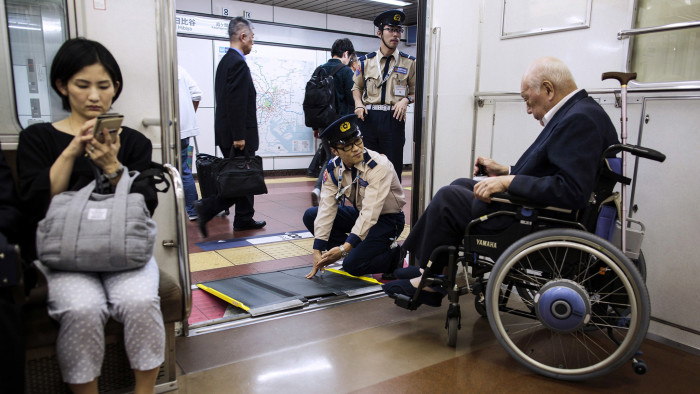Japan companies in ‘hiring war’ to hit disability targets

Roula Khalaf, Editor of the FT, selects her favourite stories in this weekly newsletter.
When Satoshi Fukuda was appointed head of a subsidiary at Japanese mobile gaming company Gree in late 2013, his 30-strong workforce was assigned the main daily task of shredding papers. It was an ordinary task for a unique team: most of the subsidiary’s workers has some type of mental disability.
Five years on, the scope of the work his staff handle has vastly expanded to include the removal of computer bugs and researching game patents — tasks that feed into Gree’s core business.
“The change did not happen overnight. It is not something that other companies can replicate easily,” says Mr Fukuda, the president of Gree Business Operations. He recalls spending years trying to convince colleagues to assign more responsibilities to disabled staff.
Examples such as Gree are rare in Japan. Disabled people continue to suffer discrimination and social isolation. Despite a push by Prime Minister Shinzo Abe, efforts by employers to improve inclusion have fallen short of expectations. “There is still a tendency to view people with disabilities as different from everyone else,” says Yoshihiko Fukushima, professor at Waseda University in Tokyo. “The attitude of companies is that they are doing a favour by hiring the disabled.”
Attitudes and awareness, though, are changing slowly. As Tokyo plans to host the Summer Olympics and Paralympics in 2020, the government is upgrading the city’s infrastructure and subways to improve accessibility. City leaders hope to replicate the success they had in 1964 when Tokyo hosted the Paralympics for the first time. The international sporting event for disabled athletes is now widely credited for raising disability awareness in postwar Japan.
In April, Japan raised the legal employment quota for disabled people from 2 per cent to 2.2 per cent. The quota, which applies to companies with 45.5 or more workers, will increase to 2.3 per cent within the next three years.
In practice, only about half of Japanese companies meet the quota. The rest pay a monthly levy that is then distributed to firms that exceed it. Many European and Asian countries including Germany, France and South Korea adopt a similar quota system. But others such as the US and UK consider anti-discrimination legislation more effective.
Two years ago, Japan also passed a new law aimed at eliminating discrimination against people with disabilities. However, according to a survey carried out last year, 84 per cent of respondents thought there was continuing discrimination against disabled people.
Experts also say much of the employment by Japanese companies is driven by compliance pressure and a sense of obligation. “Large companies are actively increasing employment of disabled people for compliance reasons but there are cases where the capabilities of disabled employees are not fully utilised,” says Wataru Takasawa, deputy director at the Ministry of Health, Labour and Welfare, who handles disabled employment measures.
The increased quota has highlighted a particularly tight talent pool for people with physical and mental disabilities. “There is a hiring war in areas around Tokyo and even big companies are finding it difficult to hire,” says Keisuke Mizunoura, a senior researcher at Nomura Research Institute.
The employment rate for disabled workers in Japan is 48.6 per cent, compared with 59 per cent for the overall workforce, according to government statistics. The government has added a new obligation for companies to hire people with mental disabilities, who make up only 10 per cent of 496,000 disabled workers in the private sector.
Gree is one of the few companies that have actively hired people with developmental disabilities, depression and other mental health issues, partly because it found that many of them have an affinity for animation and games. Other employers have raised concerns about turnover and the complexity of such disabilities.
To create a working environment suited to its disabled employees, Gree’s office has partitions for desks, a resting space and regular counselling sessions. It is also equipped with sunglasses and headphones for people who are sensitive to light and noise. Outside agencies help with training staff and supporting them after they are hired.
Many companies including Gree establish separate subsidiaries that mainly hire disabled workers. Proponents say this makes it easier to adapt workspace for the needs of disabled workers, but critics such as Mr Mizunoura say these subsidiaries are “ultimate forms of segregation”.
At Sony, which has been employing people with disabilities since the 1970s, the company is trying to create a system where workers at the special subsidiary can later move to other divisions inside the group. The business that has historically employed disabled staff handles the design, manufacturing and customer service for microphones. Half of Sony’s 800 disabled employees now work outside this for the wider group.
“People will not last just because there is a friendly working environment,” says Shingo Mori, senior manager at Sony’s human resources division. “Regardless of disability, there needs to be a climate where employees feel they can challenge themselves to do the things they want with their career.”

Comments